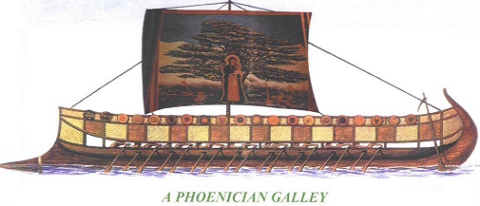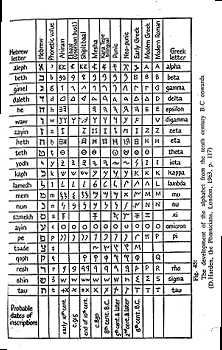![]()

"The
Just man shall flourish, like the Cedar of Lebanon shall he grow; planted in
the house of the LORD, they will flourish in the courts of our God" (Ps
92:12). The Phoenician galley was built from precious Cedar wood. The rower's
are God's people rowing towards the Third Millennium. God created us, as He
planted the Cedars of Lebanon, (Ps 104:16), to grow and flourish in His love,
So that from a tiny seed, we might reach our full potential. Our Blessed Mother
Mary nurtures us, just as she did her own Son, and guides us towards God's plan
for us.
History tells us that the Canaanites, a tribe of Semitic
origin, were first to inhabit the Lebanese shores. Indeed their culture is said
to form the basis of the Aramaean culture of both Syria and of Israelite
Palestine. The Canaanites who traded with the Greeks became known by them as
Phoenicians.
Lebanon started to be called such by name sometime in the
third Millennium before Christ, when reference is made to the Pharoahs of Egypt
importing cedar wood from the mountains of Lebanon.
The term Phoenicia,
from the Greek Phoenix, means purple-red, and refers to the purple industry
(the dye extracted from the mollusc shell-fish and used to colour cloth) of the
early Lebanese.
The word Lebanon itself, is an ancient Semitic term meaning “White”, and the country was so called as the Lebanese mountain summits remain snow-decked for most of the year. Seeking trading partners, the Phoenicians sailed further away from the shores of Lebanon, confident in their legendary vessels crafted in solid cedar wood.
By the end of the second century BC, they had colonised most of the
Mediteranean shore, establishing trading depots and spreading the Semitic
culture. The greatest of these colonies is said to have been Carthage. From the
Mediteranean, the Phoenicians moved westward, eventually discovering the
Atlantic Ocean.
They rounded Africa, landed in England and Ireland and built
many cities in Western Europe and on the Atlantic coast of Africa. But while
the Phoenicians became legendary traders - their wares included works of art,
textiles, delicate glassware, precious stones and perfume - their intellectual
contribution to society guaranteed their place in history.
They gave the world the twenty-two "magic signs"
called the alphabet, the first developed system of modern writing and numerical
figures. They also taught mankind the art of stone building and glass
manufacturing.
Phoenicia (foh-NEE-shee-ah)
THE PHOENICIANS
ROUTES
PHOENICIANS IN HISTORY
There is no doubt the the Phoenicians were among the
most interesting people in history. Because they left so few written records of
their own achievements, their history has been pieced together from records of
all the other nations with which they came in contact, either through trade or
through battle. Other information has been gathered from the work of
archaeologists whose digging have unearthed tombs of their rulers or what
little is left of their cities.
THE OLDEST CITY IN THE WORLD
Archaeologists have uncovered homes of farmers and
fishermen in Gebeil dating back to 7000 B.C. They found one-room huts with
crushed limestone floors and stone idol of god El. Because of these
discoveries, it is thought that Gebeil (later known as Byblos) may actually be
the oldest city in the world.
TIES WITH EGYPT
As far as back as 3200 B.C., the people of Gebeil
(Byblos) were cutting down cedar trees in the mountains of Lebanon, to be
shipped to Egypt and Mesopotamia for use in building ships and making columns
for houses. In return, the Phoenicians brought back gold, copper, and turquoise
from the Nile Valley and Sinai. Canaanite ceramic pieces have been found in
Egyptian tombs dating back to 2999 B.C. In 1954, archaeologists found Cheops
(khufu) at Giza. Cheops lived around 2550 B.C. A barge that was discovered in
Cheops tomb was made of Lebanese cedar wood, and faint scent of the cedar was
still in the grain at the time of its discovery.
THE
ALPHABET
Sumerian cuneiforms (wedge shaped symbols in clay
tablets) and Egyptian hieroglyphics (pictographs) were the only known forms of writing
before the alphabet as we know it was developed. Both scripts, though
separately created, used picture writing. Eventually, pictures or signs
represented sounds. Finally, the pictures became so simplified that a whole
word was written as a single sign. By about 1200 B.C., the Phoenicians had
developed symbols which in time became a real alphabet. The Phoenician alphabet
consisted of twenty-two symbols, all consonants. Each one represented its own
sound. The Egyptian symbol for the oxhead was given the Semitic name aleph, and
was sounded as "a." The symbol for house became beth, and was sounded
as "b." It is easily see how the Phoenician alphabet was used to form
the other alphabets which followed it. Aleph became the Greek alpha, beth
became beta. In time, these letters became the Roman letters A and B and
eventually the English A and B, and so on for the entire alphabet. Once a
written language was established, it was inscribed on Egyptian papyrus, a type
pf paper made of reeds. So, closely linked was papyrus with the city of Byblos,
(which traded cedar for the paper) that when the writing of the Hebrew prophets
were translated into Greek, the city's name was given to the great book - the
Bible. Because the papyrus rotted away in the damp sea air and soil, there are
practically no Phoenician writings left. Thus, the literature of the people who
influenced the western world in her writing has largely vanished. Still,
because Egyptian scribes copied the Phoenician letters after hieroglyphics were
no longer used, and because artists in Ninevah inscribed them in stone, the
alphabet remains with us.
THE CITY-STATES
For the next three centuries, independent Phoenicia
reached its height as a nation whose prime interests were trade, the arts, and
religion. Organized into individual city-states, each Phoenician city was under
its own form of government. Each had its own god and its own ruler, whose
usually remained in power for life. Gebeil (Byblos) was a strong religious
city-state. Sidon and Tyre were cities of business, industry, and navigation.
The city-states were all linked by their common ancestors, language, and
writing. Their mutual interests were their trade arrangements, their customs,
and their rituals and beliefs. Nevertheless, even though they were only a one
or two day march from each other, they never were able to unite as a single
power when they were attacked.
TYRE, THE PURPLE DYE CENTER
Tyre was the major region for thepurple dye industry,
which probably began as early as the 18th century B.C. The dye was carefully
extracted, a few drops at a time from the murex, a shell-fish found in the
waters off of Tyre and Sidon. The process used to extract the fluid was so
difficult and so expensive that only the rich could afford to buy the dyed
fabric. It is because of this Phoenician fabric that we still use the
expression "born in the purple" to mean one who is born rich.
ON THE SEA

The development of the
alphabet from the tenth century B.C. onwards.
